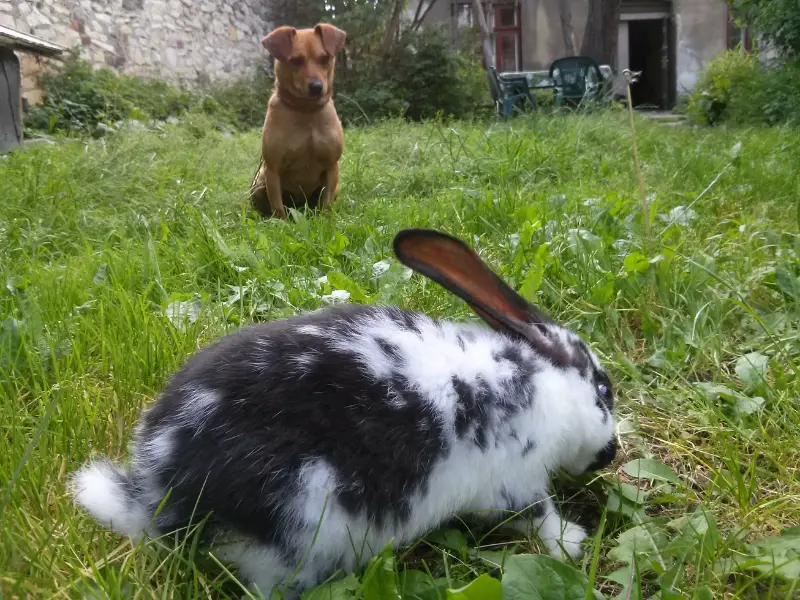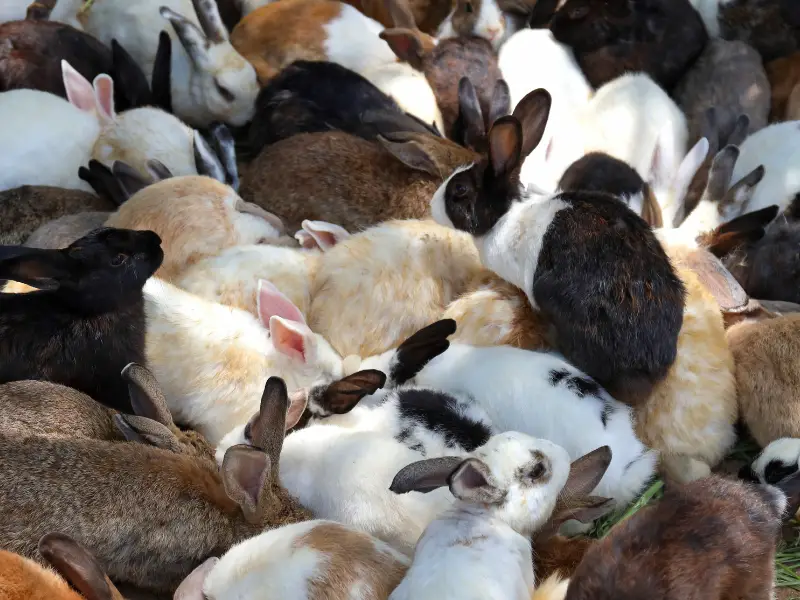Owning a rabbit and experiencing all the joy they can bring your family is truly wonderful. Before adopting one of these amazing animals, you might not have been aware of their species’ significant impact on the ecosystem.
So what exactly is the rabbit food chain?
A rabbit food chain shows how energy is passed from one organism to another. Rabbits are a significant part of the food chain and keep the ecosystem balanced. Rabbits are herbivores (primary consumers) and eat plants (primary producers). A fox is a carnivore (secondary consumer) and eats rabbits.
If you’re interested in discovering more about the rabbit food chain and what eats rabbits (and what rabbits eat), this detailed guide will provide you with all the information you’ll need.
What Is a Rabbit in the Food Chain?
Your floppy-eared friend is a herbivore, which means they eat plants (known as primary producers in the food chain.) Therefore, rabbits are categorized under trophic level 2 and are primary consumers as they gain nutrients and energy from eating primary producers (plants).
The food chain is a hierarchy of organisms that eat other organisms for energy and, in turn, may also be eaten.
Let’s take a quick look at a basic outline of the food chain:
Trophic Level 1
At the bottom of the food chain, we have the primary producers (autotrophs), which are organisms such as plants and algae.
These organisms don’t eat other organisms. Instead, they get their nutrients from the ocean or the soil through photosynthesis (converting light energy from the sun into chemical energy, which sustains the plant).
Plants and organisms found in the ocean manufacture food through chemosynthesis (the process of converting molecules and nutrients into organic matter).
Trophic Level 2
At the second trophic level, we have the primary consumers (heterotrophs), which are organisms and animals such as rabbits and deer.
These animals cannot produce their own food and, therefore, need to eat other organisms, such as the primary producers.
Animals on this level are herbivores and eat plants to absorb energy and nutrients.
Trophic Level 3
At the third trophic level, we have secondary consumers. These animals eat other animals to absorb energy and nutrients. Animals on this level, such as foxes and coyotes, eat herbivores from trophic level two and are called carnivores.
We also get animals that eat both primary consumers and producers. These animals are known as omnivores (eat meat and plants).
Trophic Level 4
At the top of the food chain, we have the tertiary consumers, which are carnivores that eat other carnivores (such as the orca) to absorb nutrients and energy.
After this level, you get the decomposers (such as mushrooms and bacteria), which break down dead plant and animal matter and release it back into the ecosystem for recycling.
Why Are Rabbits Important in the Food Chain?

Your bun may seem like a cute and cuddly ball of fun, but these intelligent animals are important for keeping the ecosystem balanced.
Let’s take a look at some of the reasons why rabbits are essential in the food chain:
- Rabbits are grazers, which means they eat pretty much all day long. If it weren’t for rabbits eating many plants and weeds, the weed population would be out of control. By eating weeds, rabbits give other plants a chance to thrive, which adds biodiversity to the ecosystem.
- The urine and droppings from a rabbit provide the soil with nutrients and keep it healthy, which in turn helps the plants grow.
- Rabbits are also an excellent and abundant (year-long) food source for predators. They provide carnivores and omnivores with meat rich in vitamin E and B12.
Without the constant food source that rabbits provide for omnivores and carnivores, the ecosystem would be out of balance, and the food chain could collapse.
Are Rabbits Bottom of the Food Chain?
Contrary to popular belief, your bun is not at the bottom of the food chain. Rabbits are on level two of the food chain as they can’t produce their food.
Organisms such as plants and species of bacteria are at the bottom of the food chain, as they can make their food.
Above this level are the herbivores, organisms, and animals, such as rabbits, who feed on the organisms from the first level. An example of a food chain would be:
carrot (primary producer) > rabbit (primary consumer) > coyote (secondary consumer)
The rabbit eats the plants, and the coyote eats the rabbit.
What Does a Rabbit Eat?
Here’s a look at the different diets of a wild and domestic rabbits:
Wild Rabbits
Wild rabbits like the Eastern Cottontail don’t eat rabbit food like domestic rabbits. They eat food such as:
- Twigs
- Grass
- Young plant shoots
- Dandelions
- Bark
- Hay
Domestic Rabbits
Domestic rabbits eat a healthy and balanced diet that consists of the following:
- Good quality Timothy grass hay
- Fresh leafy greens such as carrot tops, mint, romaine lettuce, basil, and spinach
- A good quality pellet rabbit food that contains fiber, minerals, and vitamins
- The occasional snack such as bits of fruit like blueberries or bananas
Is a Rabbit a Primary Consumer?
Rabbit is herbivores (primary consumers) as they eat primary producers (plants). Rabbits cannot produce their own food and absorb their energy by eating plants.
Is a Rabbit a Producer?
A rabbit is not classified as a producer simply because it cannot produce its own food source.
Rabbit is herbivores and primary consumers as they only eat primary producers (plants).
My Last Bunny Thoughts
Without rabbits, weeds would grow out of control, and carnivores would go hungry. Rabbits also give back to nature with their nutrient-rich urine and droppings. At the end of the day, rabbits are an essential part of the food chain, and they help keep the cycle balanced.
That being said, if carnivores didn’t eat rabbits, the world would be overpopulated with rabbits. Due to their rapid reproduction process, this could cause chaos in the ecosystem. Every organism and animal has a role to play.
So the next time you sit with your fluffy bun, take a moment to appreciate these little animals’ big impact on our ecosystem. Luckily, thanks to their sheltered life, your bun never has to worry about being a food source for a coyote or a fox.
Related Articles:

